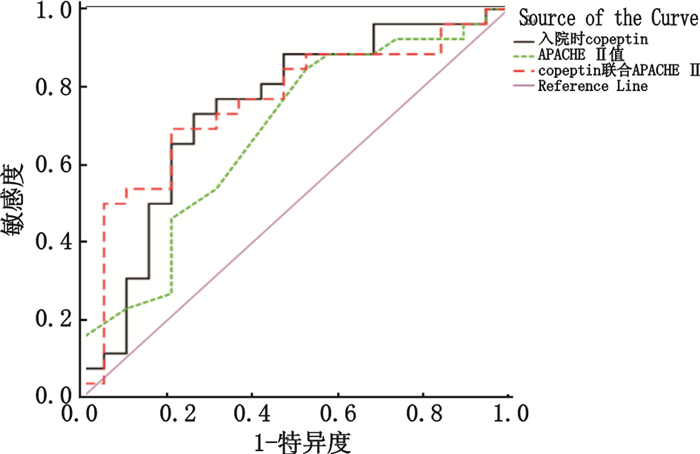重症肺炎是ICU常见疾病,可短时间内出现休克、肾功能不全等多系统损害,常合并糖代谢紊乱,病情重,发展快,病死率高。流行病学调查显示病死率高低不一,报道20%~70%不等[1]。Copeptin是精氨酸加压素(AVP)同源激素,可以反映多种疾病的严重程度和预后。本研究旨在探讨重症肺炎患者血浆copeptin和疾病严重性、预后与血糖的关系。
1 资料与方法 1.1 一般资料选择2013年5月至2014年9月入住复旦大学附属华山医院重症肺炎患者。另选本医院健康体检者30例作为对照组。均在本院人类伦理指导委员会批准下并签署知情同意下进行。
入选标准:全部病例符合2007年美国感染病学会和美国胸科学会重症肺炎诊断标准 [1]。排除标准:使用糖皮质激素的患者、恶性肿瘤、急性心肌梗死、慢性肝肾功能衰竭患者、年龄<18岁、孕妇、糖尿病患者。
1.2 检测方法入院时抽取静脉血3 mL,用乙二胺四乙酸抗凝管收集,3 000 r/min离心10 min,将血浆保存在-80 ℃低温冰箱待测copeptin。采用ELISA检测,试剂由上海江莱生物科技有限公(中国,上海)司提供。记录入ICU时血气分析、C反应蛋白(CRP)、血糖、 APACHEⅡ值等基本资料。
1.3 血糖监测、控制方案血糖监测采用葡萄糖氧化酶检测方法;入院血糖≥10.0 mmol/L即启动胰岛素治疗,目标血糖为7.8~10.0 mmol/L[2];血糖控制参照美国糖尿病医师协会推荐The NICE-SUGAR study方案[3]。
1.4 统计学方法计量资料以均数±标准差(x±s)或中位数(四分位数)表示。两独立样本均数比较用成组t检验或Mann-Whitney U检验。相关性分析用Spearman或Pearson法。多因素COX回归分析28 d死亡危险因素,绘制ROC曲线。采用SPSS 17.0软件统计学处理,以P<0.05为差异具有统计学意义。
2 结果 2.1 基本资料入院50例重症肺炎患者,排除糖尿病、合并心肌梗死、心力衰竭及中途退出等5例,最终入选45例,年龄(66.87±12.55)岁,男性24例,女性17例。健康对照组30例,年龄(64.13±5.85)岁,男性13例,女性17例。两组在年龄、性别构成比差异均无统计学意义(P>0.05)。重症肺炎组较健康对照组copeptin水平(pmol/L)明显升高(62.24±28.28 vs. 10.14±5.05,P<0.01)。死亡19例,病死率为42.22%。
2.2 copeptin与疾病严重程度的相关性分析入院时copeptin和APACHEⅡ呈正相关(r=0.481,P=0.001);控制年龄、血糖、氧分压、渗透压、CRP等可能存在影响因素后,两者仍有相关性(r=0.327,P=0.04)。
2.3 不同预后患者入院时copeptin水平的比较根据预后分为存活组和死亡组,两组在性别、年龄等差异无统计学意义(P>0.05)。但是死亡组入院时copeptin明显升高,见表 1。
| 指标 | 存活组(n=26) | 死亡组(n=19) | t/Z/χ2 | P值 |
| copeptin(pmol/L) | 52.78±22.82 | 75.18±30.42 | 2.83 | 0.007 |
| 年龄(岁) | 64.50±12.47 | 70.11±12.23 | 1.50 | 0.141 |
| 男性/女性(例) | 13/13 | 11/8 | 0.26 | 0.600 |
| WBC(×109) | 13.83±4.25 | 14.61±5.42 | 0.54 | 0.594 |
| CRP(mg/L) | 96.38±39.63 | 113.53±40.24 | 1.42 | 0.162 |
| 渗透压(Osm) | 297.46±8.63 | 297.11±7.06 | 0.15 | 0.884 |
| 肌酐(μmol/L) a | 73.75-104.25 | 74.00-104.00 | 0.01 | 1.000 |
| APACHEⅡ值 | 20.84±5.18 | 24.37±5.71 | 2.16 | 0.037 |
| 发病至入院时间(d) | 4.06±1.97 | 4.32±1.94 | 0.44 | 0.664 |
| 注: a为四分位数;两组copeptin比较, P<0.01 | ||||
按copeptin中位数分为高copeptin组(≥63.80 pmol/L)和低copeptin组,Kaplan-Meier生存分析显示高copeptin组患者28 d生存率明显降低(Log Rank χ2=10.417,P=0.001),见图 1。
 |
| 图 1 生存曲线 Fig 1 Survival Functions |
在45例患者中,28 d内死亡19例。单因素分析死亡危险因素,APACHEⅡ(OR=1.159,P=0.002)、氧分压(OR=0.929,P=0.033)、copeptin(OR=1.031,P=0.001)、血糖均为危险因素(OR=1.063,P=0.004);多因素COX生存分析(Forward:Wald),最终只有copeptin(OR=1.022,P=0.005)、APACHEⅡ(OR=1.120,P=0.043)、血糖(OR=1.112,P=0.048)进入方程,是28 d死亡独立危险因素。
2.5 copeptin对重症肺炎患者预后的评估作用绘制copeptin、APACHEⅡ、APACHEⅡ+copeptin的ROC曲线,三者ROC面积分别是0.740 9、0.680 2、0.755 1,均P<0.05;三者面积间差异无统计学意义(χ2=3.04,P=0.218 2);预测死亡的敏感度分别为0.731、0.846、0.692,特异度分别为0.269、0.154、0.308,见图 2。
 |
| 图 2 ROC曲线 Fig 2 ROC Curve |
所有患者入院时copeptin和血糖正相关(r=0.417,P=0.004)。校正年龄、氧分压、CRP、渗透压、APACHE Ⅱ等可能影响因素后,仍然有相关性(r=0.403,P=0.010)。进一步将所有患者分为高血糖组、非高血糖组。高血糖组19例患者,copeptin和血糖正相关(r=0.505,P=0.027);校正APACHEⅡ、氧分压、年龄、渗克分子浓度等可能存在的影响因素后,仍正相关(r=0.521,P=0.047)。非高血糖组copeptin与血糖无相关性(r=0.138,P=0.500),见表 2。
| 组别 | 校正前 | 校正后 | ||
| r值 | P值 | r值 | P值 | |
| 所有患者(n=45) | 0.417 | 0.004 | 0.403 | 0.010 |
| 非高血糖组(n=26) | 0.138 | 0.500 | 0.023 | 0.919 |
| 高血糖组(n=19) | 0.505 | 0.027 | 0.521 | 0.047 |
血糖≥10 mmol/L需要胰岛素治疗者19例,copeptin和24 h胰岛素总量呈正相关(r=0.556,P=0.009),在校正血糖、24 h热卡总量、渗透压、以及APACHEⅡ后,仍然存在相关性(r=0.506,P=0.038)。
3 讨论精氨酸加压素(AVP)是下丘脑分泌的9肽激素,具有缩血管、升高血压和抗利尿的作用,参加机体渗透压和神经中枢调节,还参与机体的应激反应。当机体血流动力学或血渗透压该变时,与AVP由神经垂体等摩尔快速释放到血液中。在多种病理情况下如低血压、高渗透压、低氧血症、酸中毒等升高[4],与急性心肌梗死、肺炎、sepsis、肝功能不全、慢性阻塞性肺疾病、肺癌等多种疾病的严重程度和预后密切相关,被认为是这些疾病的重要预警分子[5]。它还是体内最强的应激激素之一,可以促进皮质醇、胰高血糖素、儿茶酚胺类等胰岛素反向激素的释放,导致血糖升高[6]。AVP在体内、体外半衰期均很短,检测非常困难,难以在临床上广泛应用[7]。copeptin是AVP的同源激素,来源于精氨酸加压素原(精氨酸加压素原由信号肽、AVP、copeptin和neu-rophysinⅡ组成),和AVP等摩尔分泌,犹如胰岛素和C肽的关系[4]。Copeptin的分泌、体内代谢和AVP极为相似[8],主要通过肝、肾和酶代谢,但是它在体外稳定,室温下放置可以稳定长达7~14 d,所以通常以测定copeptin来反映AVP水平[9]。
在本研究中,重症肺炎患者入院时copeptin可以反映疾病严重性、预后。copeptin和APACHEⅡ值呈正相关(r=0.491,P=0.001),提示入院时病情越重,则copeptin值越高。死亡组较生存组copeptin明显升高,在Kaplan-Meier累计生存率比较上也发现copeptin≥63.80 pmol/L时,28 d生存率明显下降。COX多因素回归分析28 d死亡危险因素,入院时copeptin最终进入方程,是28 d死亡的独立危险因素;同时发现,入院时copeptin值在识别预后不良患者能力方面,和APACHEⅡ值不相上下,两者的ROC曲线下面积分别为0.740 9、0.680 2,两者差异无统计学意义(P=0.218 2)。让人失望的是,两者联合仍然未能提高ROC面积(0.755 1),在识别不良预后患者上并无明显优势(P=0.218 2)。作为一种应激激素,copeptin成为多种疾病的诊断、严重性、预后的指标[10, 11],已经许多研究,copeptin可以作为重型颅脑外伤[12]急性心肌梗死[13]、心力衰竭[14]、脓毒症[15]、呼吸机相关性肺炎[16]等危重患者的危险分层、预后评估的可靠工具。
通过恰当评估,可以针对性采取干预措施,优化护理和医疗资源配置,改善患者的预后。目前评价肺炎严重程度和预测预后的评分系统主要有肺炎严重度指数(PSI)和APACHEⅡ评分系统[17]等。但是它们均有一定的局限性。APACHEⅡ评分系统项目繁多,要完全获取数据需要 2 ~24 h,在一些基层医院,医疗设备尚不能完全获取APACHEⅡ评分所需参数,且该评分系统计算繁琐,耗费时间,故在实际临床应用中存在许多不便之处,尤其在急诊,医务人员在嘈杂、时间紧迫的急诊室使用该评分系统的意愿大大下降,使得 APACHEⅡ评分的临床使用受到一定的限制。PSI评分同样存在类似缺点,且该评分系统过分强调年龄和合并症对预后的影响,对于较年轻患者可能会低估病情,所以PSI更适用于可以接受家庭治疗的低死亡风险患者的评估[18],从而限制了它的应用[19]。本研究发现,入院时copeptin具有和APACHEⅡ类似的作用,可以反映重症肺炎患者病情的严重性和预后。作为一种生物学指标,虽然copeptin的测定具有快速、简单、价格便宜的优势,但是否可以初步取代APACHEⅡ,广泛应用于临床,仍然需要进一步研究。
笔者还发现重症肺炎患者血糖和入院时copeptin有一定的相关性,提示copeptin可能与应激性高血糖有一定的关系,甚至参与应激性高血糖的发生。其机制可能包括以下几种:(1)AVP通过与肝脏V1a的结合,促进肝糖原分解和糖异生,升高血糖[20];(2)AVP促进胰高血糖素、皮质醇、儿茶酚胺的分泌等胰岛素反向激素的释放[6],参与胰岛素抵抗的形成。Siegenthaler等[21]发现copeptin和皮质醇呈较好的相关性,可以反映皮质醇的浓度。近年来有人提出可以把copeptin看作一种应激激素[22, 23],不同copeptin浓度反映不同的应激水平[24]。在启动胰岛素治疗患者中,copeptin和24 h胰岛素总量正相关,copeptin越高,需要的胰岛素剂量越大。推测原因,可能和不同应激程度不同相关,应激程度越高,皮质醇、儿茶酚胺、胰高血糖素等胰岛素反向激素分泌越多,血糖控制就越困难。监测copeptin可以帮助在临床上发现部分血糖难易控制的患者,促使医务人员投入更多的注意力,甚至可以适当加大胰岛素剂量,可以快速的达到血糖控制目标。
综上所述,在重症肺炎患者中,copeptin不但与病情严重性、应激性高血糖相关,而且是重症肺炎患者28 d死亡的独立危险因素,可以预测患者预后。
| [1] | Mandell LA, Wunderink RG, Anzueto A, et al. Infectious Diseases Society of America/American Thoracic Society consensus guidelines on the management of community-acquired pneumonia in adults[J]. Clin Infect Dis, 2007, 44(Suppl 2): S27-72. DOI:10.1086/511159. |
| [2] | Magee MC. Improving IV insulin administration ina community hospital[J]. J Vis Exp, 2012(64): e3705. DOI:10.3791/3705. |
| [3] | NICE-SUGAR Study Investigators, Finfer S, Chittock DR, Su SY, et al.The NICE-SUGAR Study Investigators. Intensive versus conventional glu-cose control in critically illpatients[J]. N Engl JMed, 2009, 360(13): 1283-1297.DOI:10.1056/NEJMoa0810625. |
| [4] | Balanescu S, Kopp P, Gaskill MB, et al. Correlation of plasma copeptin and vasopressin concentrations in hypo-, iso-, and hyperosmolar States[J]. J Clin Endocrinol Metab, 2011, 96(4): 1046-1052. DOI:10.1210/jc.2010-2499. |
| [5] | Griebel G, Stemmelin J, Gal CS, et al. Non-peptide vasopressin V1b receptor antagonists as potential drugs for the treatment of stress-related disorders[J]. Curr Pharm Des, 2005, 11(12): 1549-1559. |
| [6] | Karbek B, Ozbek M, Karakose M, et al. Copeptin,a surrogate marker for arginine vasopressin, is associated with cardiovascular risk in patients with polycystic ovary syndrome[J]. J Ovarian Res, 2014, 7: 31. DOI:10.1186/1757-2215-7-31. |
| [7] | Morgenthaler NG, Struck J, Jochberger S, et al. Copeptin: clinical use ofa new biomarker[J]. Trends Endocrinol Metab, 2008, 19(2): 43-49. DOI:10.1016/j.tem.2007.11.001. |
| [8] | Morgenthaler NG, Müller B, Struck J, et al. Copeptin,a stable peptide of the arginine vasopressin precursor, is elevated in hemorrhagic and septic shock[J]. Shock, 2007, 28(2): 219-226. DOI:10.1097/SHK.0b013e318033e5da. |
| [9] | Morgenthaler NG, Struck J, Alonso C, et al. Assay for the measurement of copeptin,a stable peptide derived from the precursor of vasopressin[J]. Clin Chem, 2006, 52(1): 112-119. DOI:10.1373/clinchem.2005.060038. |
| [10] | Dobsa L, Edozien KC. Copeptin and its potential role in diagnosis and prognosis of various diseases[J]. Biochem Med (Zagreb), 2013, 23(2): 172-190. |
| [11] | Iversen K, Gtze JP, Dalsgaard M, et al. Risk stratification in emergency patients by copeptin[J]. BMC Med, 2014, 12: 80. DOI:10.1186/1741-7015-12-80. |
| [12] | Zhang ZY, Zhang LX, Dong XQ, et al. Comparison of the performances of copeptin and multiple biomarkers in long-term prognosis of severe traumatic brain injury[J]. Peptides, 2014, 60: 13-17. DOI:10.1016/j.peptides.2014.07.016. |
| [13] | Reinstadler SJ, Klug G, Feistritzer HJ, et al. Long-term predictive value of copeptin after acute myocardial infarction:a cardiac magnetic resonance study[J]. Int J Cardiol, 2014, 172(2): e359-360. DOI:10.1016/j.ijcard.2013.12.301. |
| [14] | Takeishi Y. Novel biomarkers for heart failure[J]. Int Heart J,2014,55(6):474-481. DOI:10.1536/ihj.14-267. |
| [15] | Palmiere C, Augsburger M. Copeptin asa diagnostic biomarker for sepsis-related deaths[J]. Peptides, 2014, 59: 75-78. DOI:10.1016/j.peptides.2014.07.011. |
| [16] | Boeck L, Eggimann P, Smyrnios N, et al. The Sequential Organ Failure Assessment score and copeptin for predicting survival in ventilator-associated pneumonia[J]. J Crit Care, 2012, 27(5): 523. DOI:10.1016/j.jcrc.2011.07.081. |
| [17] | 王日兴,王茹春,李诗阳,等.社区获得性肺炎CURB-65与APACHEⅡ评分对比研究[J].中华医院感染学杂志,2011,21(18):3781-3783.Wang RX,Wang RC,Li SY,et al.CURB-65 criteria and APACHE Ⅱ score in community-acquired pneumonia:an comparative study[J].Chin J Nosocomiol,2011,21(18):3781-3783. |
| [18] | 陈银花,张启确,余木生. 中国社区获得性肺炎病情评估标准与肺炎严重指数的效能比较[J].中华临床医师杂志:电子版,2012,6(18):5631-5633.DOI:10.3877/cma.j.issn. 1674-0785.2012.18.055.Chen YH,Zhang QQ,Yu MS.Comparison of the efficiency of Chinese community-acquired pneumonia condition assessment standards and pneumonia severity index[J].Chin J Clinicians(Electronic Edition),2012,6(18):5631-5633. |
| [19] | Snijders D,van der Eerdedn M,de Graaff C,et al.The influence of COPD on mortality and severity scoring in community-acquired pneumonia [J].Respiration,2010,79(1):46-53.DOI:10.1159/000213757. |
| [20] | Yu GF,Huang Q,Dai WM, et al. Prognostic value of copeptin:One-year outcome in patients with traumatic brain injury[J].Peptides,2012,33(1):164-169.DOI: 2011.11.DOI:10.1016/j.peptides.017. |
| [21] | Siegenthaler J,Walti C,Urwyler SA,et al.Copeptin concentrations during psychological stress:the PsyCo study[J]. Eur J Endocrinol, 2014,171(6):737-742.DOI:10.1530/EJE-14-0405. |
| [22] | Mckel M,Searle J.Copeptin-marker of acute myocardial infarction[J]. Curr Atheroscler Rep,2014,16(7):421.DOI:10.1007/s11883-014-0421-5. |
| [23] | 付春毅,温伟,张新超.和肽素能否成为急危重症的一个良好生物学标记物[J].中国急救医学,2014,(11):1044-1047. DOI:10.3969/j.issn.1002-1949.2014.11.022.Fu CY,Wen W,Zhang XC.Feasibility of copeptin to bea biomarker in emergency and critical care medicine[J].Chin J Crit Care Med,2014,(11):1044-1047. |
| [24] | Bolignano D, Cabassi A, Fiaccadori E, et al.Copeptin (CTproAVP),a new tool for understanding the role of vasopressin in pathophysiology[J].Clin Chem Lab Med,2014,52(10):1447-1456.DOI:10.1515/cclm-2014-0379. |
 2016, Vol. 25
2016, Vol. 25




